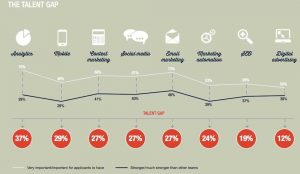The so-called “war for talent” has been raging hot ever since the phrase was coined in a McKinsey report back in 1998. In the past 20+ years, not much has changed — in fact, unemployment numbers came in at just 3.5 percent, which means that you probably have several positions to fill, and fewer prospects than ever to step into key roles.
For HR professionals, the war for talent is the new normal, and your department is held accountable for recruiting, retention, and even overall performance. Each of these responsibilities is fraught with difficulty:
- Recruiting is harder than ever, with 62 percent of recruiters reporting that it’s harder to find qualified candidates than it was five years ago. What’s more, there’s a decline in promoting from within, which means there are more positions to fill than ever before.
- Retention might be even more difficult, as the “quit rate” in the United States is at a historic high. According to Gallup, 2.3 percent of employees are voluntarily leaving their jobs on a regular basis, and a full 51 percent say they’re actively looking for work.
- Performance is highly dependent on talent levels, with studies showing that top-tier talent is between four and eight times more productive than average talent — a difference that becomes more pronounced in complex tasks.
How to win the war for talent
So how do you rise above the fray to emerge victorious in the war for talent? Here’s what you need to know:
1. Build relationships with universities
Talent is key for productivity, so it makes sense to go directly to the source. Establishing a strong presence on local college campuses builds brand awareness, so you can create some buzz for your business as a great place to work just as the youngest employees are considering their options. It’s also a great strategy to build partnerships for internships and learning with relevant academic departments. In this way you can help develop the exact skill sets you’re looking for to boost performance when you hire.
2. Compensation is just the start
Compensation is important, of course, and you’ll need to make sure you’re in line with the competition. But at the end of the day, a sky-high paycheck doesn’t lead to motivation, and it’s no guarantee that your new hire will excel in their position — or even stick around for very long. Fair pay and a balanced benefits packages are important, but you’re unlikely to be able to differentiate your company on this front, so don’t fight a losing battle by putting all your eggs a basket that ultimately looks like every other basket on offer.

3. Compete on company culture
If you can’t stand out with money, do it with culture. When pay is basically the same across the board, you need to differentiate by being a great place to work. You can’t mandate culture —?you have to build it. This is best done through:
- Employee recognition: It’s not enough to have an annual awards banquet. Today’s employees want frequent recognition. According to an Achievers report, 91 percent of employees said they “strongly” or “somewhat” agreed a strong recognition culture makes a company attractive to work for. There are dozens of ways to recognize employees, from digital celebration cards and gift cards to corporate outings. If you don’t already have an employee recognition program in place, it’s time to consider one. Building a culture of recognition encourages employees to recognize another (whether peer-to-peer or top-down) in the moment and on a frequent basis. Having a strong workplace culture built around spreading employee appreciation can lead to your company gaining a reputation for being a best place to work.
- Employee listening: No one wants to be a trench worker and follow orders forever. Employees long to be heard! When you survey them regularly and build in ways to gather their ideas, feedback, and inspiration, you don’t just show you care: you also find ways to streamline processes, eliminate waste, and build on your success. Regular pulse surveys are a great place to start —?as long as take action on the feedback you receive. Incorporating employee feedback into your company culture is critical considering 90 percent of workers say they are more likely to stay at an employer that takes and acts on feedback.
- Leadership investment: Just 9 percent of workers say leadership is “very committed” to cultural initiatives. Cultural change begins at the top, with executives and managers modeling the types of interactions and behavior they want to see from everyone else. Investing in diversity initiatives is also a great top-down way to transform company culture for the better.
Pro tip: For a look at a transformative employee recognition program, check out General Motors’ success story.

4. Train the next generation of leaders
The master stroke of strategy for winning the war for talent comes when you commit to developing internal talent. A full 60 percent of Gen-Z employees aspire to management positions, and they have sky-high expectations about being promoted within the first year of employment. While that may not be realistic, you can groom them for moving up the ladder with leadership development initiatives and scaffolded learning that lets them gradually take on more responsibility. Showing employees you trust them and want to build a future with them is one of the best ways to keep them engaged and loyal—and you’ll also create an in-house talent pool to draw from, instead of maintaining an endless cycle of recruiting.
Next steps
When you focus squarely on building a company culture that stands out from the pack, you’re poised to win the war for talent. Employee recognition and appreciation is a major piece of company culture, and HR can lead the way. To learn more about building a culture of recognition, download our free report, “Recognition Culture: The MVP of Employee Experience.”
Think you’ll need help convincing the C-Suite why recognition matters? We’ve got you covered. Get started on your presentation with help from our free resource, “Top 8 Things to Consider When Building a Business Case for a Recognition Platform.”
Business & Finance Articles on Business 2 Community
(27)





